Schneider-Kreuznach BetavaronThe Schneider-Kreuznach Betavaron 3...10/0.08 (more on this strange denomination below) is a very unusual type of enlarger lens manufactured in the 80s. It was very expensive (reportedly, 2,000 US$), and meant primarily to be used in automated or semi-automated enlargers for large-volume production of BW and colour prints (i.e., the type of machine that a photo lab would use). Besides its price and large size (the picture below shows it side-by-side with the EL-Nikkor 50 mm f/4, which is a rather small, general-purpose enlarger lens), it is unique in being a zoom lens. As far as I know, this is the only zoom designed for darkroom printing. Its intended use and high price are reflected in the materials used for its mechanical parts. Most of the barrel and rings are massive, and many parts are made of brass, instead of aluminium. At 781g, it weights twice as much as consumer zooms of similar size. An equally massive chrome-plated hardened steel (!) retaining ring was supplied with the lens (at least in my specimen). Mounting this lens onto plastic threaded lens boards like those used on some cheap enlargers would seem risky to me, and the weight is very likely to strain the bellows adjustments of many enlargers. Photography shops occasionally offer unused specimens of this lens for around 100-150 US$. Used specimens on eBay may go for half of this price, but are seldom available. 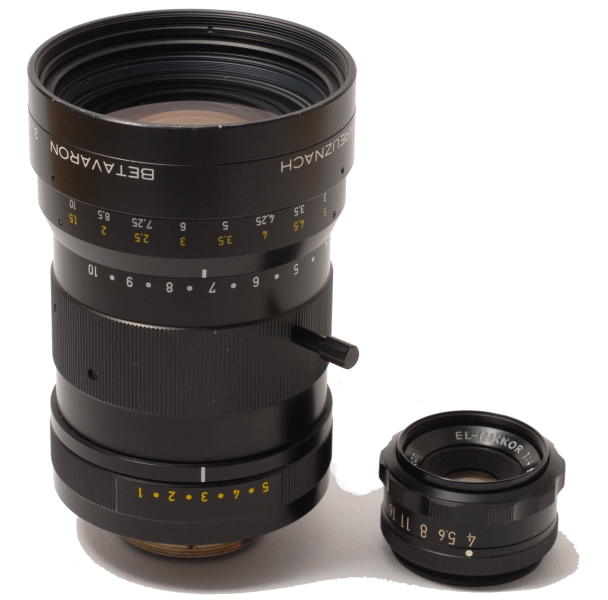
The optical design is quite complicated, with 11 elements in 10 groups. The mechanical design is conservative, with two internal groups moved by cams, and fixed front and rear groups. The moving groups slide on solid internal metal rods, and I can see no trace of plastic anywhere (except for the front and rear lens caps). The lens mount is a 39M x 0.5 thread, which is standard for enlarger lenses of shorter focal lengths. The lens is designed to cover the 35mm format. Being an enlarger lens, it does not have a focusing ring. Focusing is carried out with the focusing mechanisms of the enlarger. The Betavaron 3...10 is designed to be used at a fixed distance from the film and the paper, and to provide reproduction ratios in the range 1:3 - 1:10 by turning the zoom ring without refocusing. Documentation on the Schneider web site states that the lens can mount a matched accessory lens (called VL in the documentation) on its front bayonet. This changes the range of reproduction ratios to 1:5.3 - 1:17. My specimen does not have a front bayonet and did not come with a VL lens, so at least a few different models of Betavaron must exist (indeed, judging from pictures on the Web, several models do display visible differences in barrel construction and other details). Instead of the front bayonet, my specimen has a threaded retaining ring that sits in an apparently non-standard 71mm front filter mount, where it holds nothing and has no apparent use. It could be used to hold an accessory lens permanently mounted there, but it is obvious from the condition of the thread and ring that such a lens was not originally present in this position. There are also mentions in the literature of 3.1...10 and 3.5...11 models. The zoom ring is not graduated in focal lengths, but in reproduction ratios, which is sensible because of the specialised use for which this lens was designed. In my specimen, the scale ranges from 3 (i.e., 1:3, or 0.33x) to 10 (1:10, or 0.1x). A lever can be mounted in any of three threaded holes on the zoom ring to make it easier to turn the ring. Zooming through the whole range requires less than half a turn of the ring. The specifications report a focal length range of approximately 50-125mm, and a film-to-subject (film-to-paper if used on an enlarger) distance of 648mm. Since the zoom ratio is only roughly 2.5 and the working distance remains constant, the range of reproduction ratios must be accompanied by movements of the nodal points of the lens. As a whole, this lens design would seem to be a major achievement. Another peculiarity of the Betavaron is that its diaphragm ring is graduated from 1 to 5, with clicks also half-way between these numbers. The numbers obviously are not diaphragm stops, and seem to be arbitrary units. The documentation says that closing the diaphragm by one full unit halves the amount of light passing through the lens. The maximum effective aperture ranges between f/4.1 and f/5.6, and is dependent on the focal length. Based on this data, one unit corresponds to one stop, and the minimum aperture should be 4 stops more, i.e., approximately f/16 to f/22. This may visibly degrade the image due to diffraction, so choosing an aperture somewhere in the middle of this range is likely a good bet, as long as a high depth-of-field is not necessary. The denomination of the lens also contains a /0.08 part, for which I have no good explanation. It might express an average value of the effective aperture, in relation to the distance from the film plane. The diaphragm aperture of the Betavaron is far from being circular (which is one of the factors that are usually said to contribute to high quality pictures, or good bokeh, in out-of-focus areas of macro and close-up lenses). In fact, the diaphragm shape is a pentagon with concave sides and projecting vertices, i.e., about as far as possible from an ideal diaphragm shape. On the other hand, the Zeiss Tessovar, which is a zoom designed for close-up, macro and photomacrography, does have a similar diaphragm, and gives excellent results in spite of this. Apparently, the shape of the diaphragm may not be very important at high reproduction ratios. A table printed on the lens barrel (and repeated in the documentation) indicates the aperture value that should be used at each reproduction ratio, in order to maintain a constant exposure time when printing. The values range from 1.5 to 5, which uses up almost the whole range. Interestingly, this seems to suggest that the lens should be stopped down to 1.5 (i.e., one stop) or more when in use. Opinions on this lens are very variable, and range from contempt to admiration. It is variously regarded as essentially useless for normal darkroom work (in the words of one reviewer, a solution to a problem we don't have), as a lens designed to save time at the expense of quality in the mass-production of photographic prints, or alternatively, as a lens that every darkroom should have, but that few photographers can afford. There is no consensus, either, on its optical performance. Therefore, I had no reliable guidance, and decided to try out the Betavaron for myself when a used specimen became available at a reasonably low price on eBay. It was described as having quite a bit of mould on internal lenses, but I took the risk nonetheless. As it turned out, disassembling the fixed front elements took only a few minutes (by unscrewing four front retaining rings), and the mould, although extensive, had slightly etched only the lens coatings of two lens surfaces, not the glass itself, and was easily removed. Disassembly of the moving elements would have been much more difficult, but it proved unnecessary. I am storing this lens for a while in a plastic bag together with a fungicide and silica gel bag as a precaution, but in my local climate lens mould is not a problem. 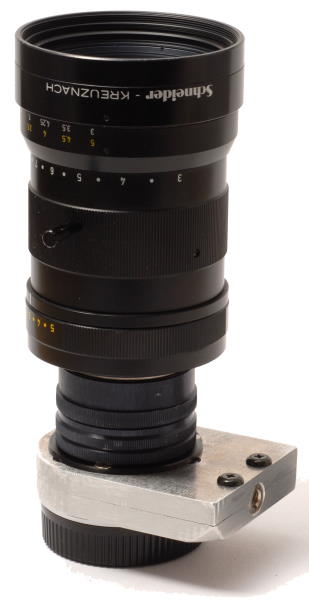
Aside from its technical specifications (and an unreasonable affection for enlarger lenses, now that digital photography has made them useless), my interest in this lens was to test whether it could be used in close-up photography. The 1:3 to 1:10 range of reproduction ratios is most useful for this application, and the lens is specifically optimized for this range. In addition, the use of a parfocal zoom (i.e., a zoom that does not need refocusing when the focal length is changed) allows a very efficient work routine when many pictures must be taken at different reproduction ratios. This is what I frequently do, and, incidentally, this is also what the Betavaron is designed to provide. If you need to take only a few tens of close-ups, you can easily change the working distance and refocus. On the other hand, if you must take hundreds or thousands of close-ups in a few hours of objects difficult and/or expensive to access, every help counts. A small amount of refocusing, by using a focusing rack or comparable means, is quick and acceptable when changing the subject, but the major changes in camera-to-subject distance required to change reproduction ratio with a lens of fixed focal length involve time-consuming adjustments of a tripod or repro stand by trial and error, and sometimes even re-framing. The only high-quality alternatives to the Betavaron I am aware of are the Micro Nikkor 70-180 mm and the Zeiss Tessovar. The former is the only zoom designed by Nikon for close-up and macro photography (we are talking here about real macro lenses, not the "macro" denomination used by many manufacturers, which is little more than a marketing gimmick). Actually, the 70-180 focuses from infinity to 1:1.3, so it is not, properly speaking, a macro lens, but it is close enough. However, its zoom ratio is less than 2.6, and it needs changes in subject-to-camera distance and refocusing outside this range. Although it is a very good lens, its capabilities are limited with regard to the uses that make a parfocal macro zoom really useful. The Tessovar is designed for macro photography in the 0.4x to 12.8x range, and, although it employs an optical zoom, it achieves this full range by switching accessory lenses mounted on a revolving front adapter and changing the working distance. Although the Tessovar is a very competent piece of equipment and unique in many respects, its capabilities and purposes are completely different from those of the Betavaron. Interestingly, the Betavaron, Tessovar and Nikkor 70-180 are all discontinued, together with the vast majority of specialised, professional equipment for macro, close-up and photomacrography. The extremely high cost of producing this type of equipment and the small size of the potential market are the most likely causes, in the context of a profit rationale that dictates cheap cameras and lenses churned out by the millions. Fortunately, the supply of second-hand equipment is still sufficient, and the prices generally reasonable. A few photomacrographic lenses, like the Zeiss Luminars and Leitz Photars, command very high prices because they have become collector's and status items, but cheaper alternatives are available. There is, nonetheless, an ample choice of new macro lenses for generic use, generally of very good quality, which offer only a fixed focal length and typically focus between infinity and 1:1. The specified distance between the front lens element of the Betavaron and the subject (or paper, when used on an enlarger) is 467mm, which is quite comfortable for close-up. The lens has a specified distance of 73mm between film/sensor plane and rear element (it must be a retrofocus design, considering the shortest focal length is 50mm), which is more than enough to mount the lens onto a DSLR via an adapter (Nikon SLRs and DSLRs have a 46.5 mm register distance, i.e., the distance between lens mount flange and film/sensor plane). In my specimen, the rear element hood projects 8 mm behind the lens mount flange (the rear element itself slightly less than this, or approximately 6.5 mm. Therefore, this adapter should have a length of 18.5 or 20 mm, depending on which measurement is used. This distance should be matched quite closely, in order to maintain the parfocality of the Betavaron (although, in practical use, a focusing rack is needed for adjustments of a few mm to a few cm in camera-to-subject distance whenever the subject is changed). Therefore, small deviations from the optimal adapter thickness are not critical, unless you absolutely need to preserve parfocality. In my case, I use a stack of M39 extension rings and a 38 mm to Nikon adapter I manufactured by attaching together an EL-Nikkor retaining ring, a 2 mm thick flange and a Nikon bayonet. I obtain near-parfocality with a set of extension rings, but in practical tests I have been able to increase or decrease substantially their length in order to change reproduction ratios, without visible losses in resolution (at the expense, however, of parfocality). All in all, my expectations for this lens were quite high and perhaps unrealistic, but only practical tests could answer my questions. 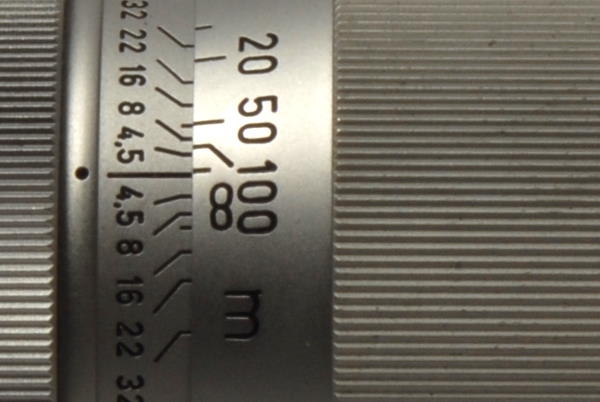 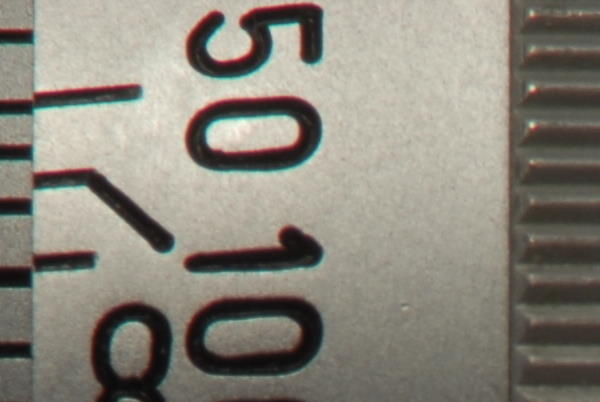
The above pictures are 1:1 crops of 10 megapixel pictures taken at the minimum and maximum zoom ranges. The best resolution is obtained with the diaphragm fully closed ("5" on the diaphragm ring), and the above tests are taken at this setting. Resolution at minimum zoom is good but just a little bit soft in the smallest details. At maximum zoom, the picture is slightly softer and suffers from visible chromatic aberration. 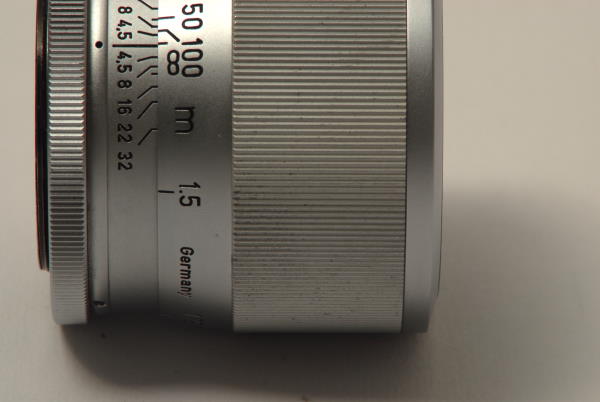
These pictures are still quite usable for most purposes, as the reduced full-frame above (taken at maximum zoom, i.e., lowest performance) shows. Unless the picture is enlarged to a substantial size, the overall impression is of very high - almost merciless - sharpness, contrast and depth of field (so sharp and high in contrast, in fact, that the image compression for web publishing creates very visible artefacts, especially around the engraved numbers). The images also seem to lack any barrel or pincushion distortion, to the point of being more similar to technical drawings than photographs. However, unless there is a strong reason for using the parfocality provided by the Betavaron, a good quality macro lens of fixed focal length will provide better results for what concerns resolution and chromatic aberration. I have been toying with the idea of testing the Betavaron in photomacrography, like other enlarger lenses. However, it is not very practical to do so while keeping the zoom parfocality, because this would imply using it reversed on bellows about 40 cm long (because the total subject-to-film distance would have to remain the same as in normal use of the lens, in order to provide parfocality). Given the not-too-exceptional performance at maximum zoom, the Betavaron probably would not be a top performer in photomacrography. In conclusion, the Schneider Betavaron is an unusual lens that, in special circumstances, may help a photographer to save time when taking large numbers of close-up or copy pictures at different reproduction ratios, thanks to its parfocal zoom capabilities. However, in terms of resolution, it does not perform as well as a good macro lens of fixed focal length. |